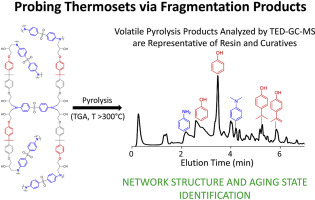Polymer Degradation and Stability ( IF 5.9 ) Pub Date : 2019-11-21 , DOI: 10.1016/j.polymdegradstab.2019.109032 C. Garrett Campbell , Dominik Jordon Astorga , Erik Duemichen , Mathew Celina

|
Thermoset materials characterization is often limited to solid state analytical techniques such as IR, NMR, DSC, TGA and mechanical testing. Alternatively, their off-gassing behavior can also be evaluated using GC based techniques such as TD-GC-MS, allowing this method to be applied to thermoset materials analyses such as identification, aging characterization, and formulation optimization. As an overview, common thermoset materials were evaluated by analyzing their gaseous degradation products via TGA-based pyrolysis and subsequent TD-GC-MS for the identification of representative volatile signatures. It is thereby possible to distinguish different classes of phenolic materials or cured epoxy resins, as well as their amine or anhydride curatives. Additionally, this method enabled quantification of a volatile fragment (bisphenol A, BPA) which is associated with oxidation of epoxy/amine thermoset materials. The amount of evolved BPA increased linearly with aging time and this trend exhibits linear Arrhenius behavior over the temperature range (80–125 °C) studied, in agreement with oxidation sensitivies based on oxygen consumption data. Further, TD-GC-MS was used to explore how off-gassing of residual anhydride curative from an epoxy/anhydride material depends on formulation stoichiometry. Even in formulations that theoretically contain enough epoxy to consume all anhydride (1:1 stoichiometry), residual anhydride remained due to imperfect final cure state and could evolve from the material. For such materials, a slightly epoxy-rich formulation is required to ensure that the material contains no residual unreacted anhydride. Analysis of volatiles generated by thermal exposure is an attractive characterization approach enabling compositional analysis as well as complementary diagnostics for materials degradation.
中文翻译:

通过基于热脱附或热解的气相色谱-质谱法表征热固性材料
热固性材料的表征通常仅限于固态分析技术,例如IR,NMR,DSC,TGA和机械测试。或者,也可以使用基于GC的技术(例如TD-GC-MS)来评估其放气行为,从而允许将该方法应用于热固性材料分析,例如鉴定,老化特性和配方优化。总的来说,通过基于TGA的热解和随后的TD-GC-MS分析其气态降解产物来评估常见的热固性材料,以鉴定代表性的挥发性特征。因此可以区分不同种类的酚醛材料或固化的环氧树脂,以及它们的胺或酸酐固化剂。此外,这种方法还可以对挥发性片段(双酚A,BPA),这与环氧/胺热固性材料的氧化有关。BPA的生成量随老化时间线性增加,并且这种趋势在所研究的温度范围(80–125°C)内表现出线性的Arrhenius行为,这与基于耗氧量数据的氧化敏感性相符。此外,TD-GC-MS用于研究环氧/酸酐材料中残留酸酐固化剂的脱气如何取决于配方的化学计量。即使在理论上含有足够的环氧树脂以消耗所有酸酐(化学计量比为1:1)的配方中,由于不完全的最终固化状态也会残留残留的酸酐,并且可能会从材料中释放出来。对于此类材料,需要略微富含环氧的配方,以确保该材料不包含残留的未反应酸酐。



























 京公网安备 11010802027423号
京公网安备 11010802027423号